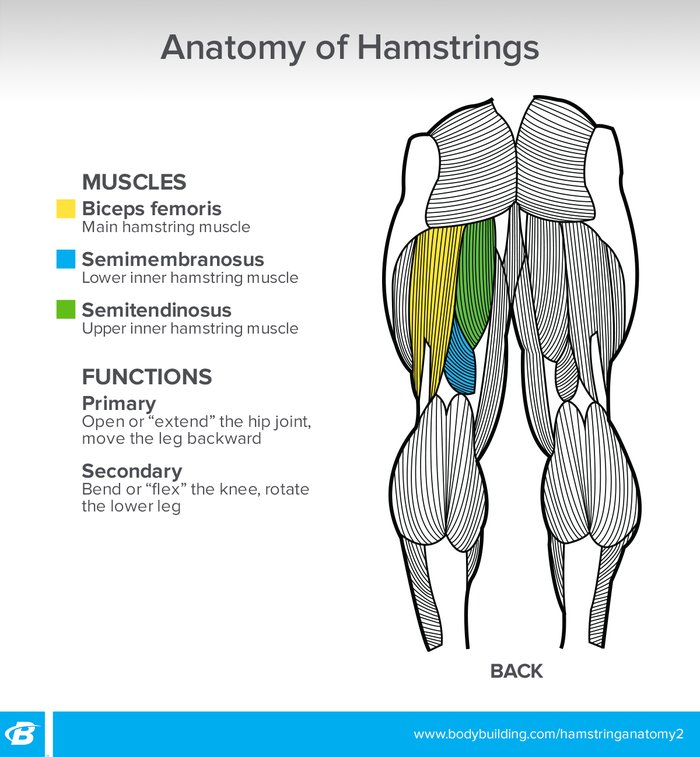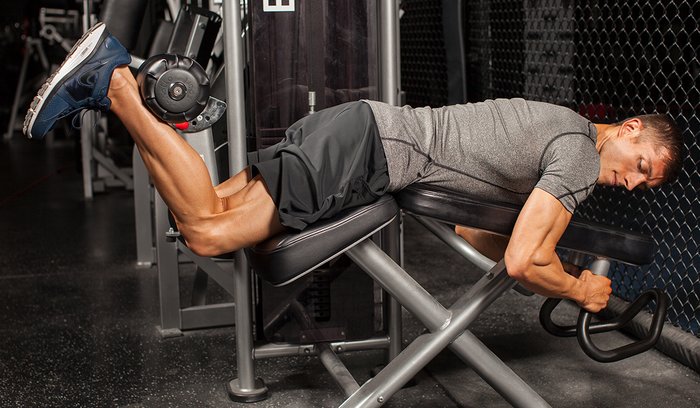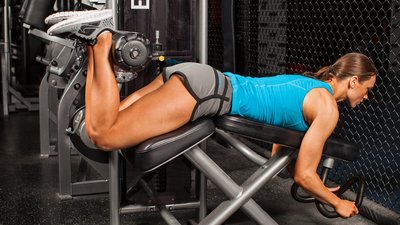Big, compound movements are where the story of getting big and strong begins, but they're not the whole story. Certain muscle groups in particular benefit from—or even demand—a little extra isolation work to be as strong and healthy as possible. The hamstrings are definitely one of these.
Have you been doing moves like deadlifts and RDLs? Great. But that's not enough. Maintaining optimum hamstring strength and functionality helps limit injury to the knee—especially those dreaded ACL tears. Even with a healthy dose of posterior chain work, many athletes have stronger quadriceps than hamstrings, putting them at higher risk for injury.
Even if you don't consider yourself a bodybuilder, you need to take a page out of the bodybuilding book here. The hamstring curl is a must for all athletes who want to develop strong, symmetrical, and muscular hamstrings that are primed for performance on the field, the stage, and in the gym!
Form Follows Function
Hamstrings are made up of three muscles: the semitendinosus, semimembranosus, and biceps femoris. The biceps femoris (just like the biceps brachii) has two "heads," a short head and a long head.
The long head of the biceps femoris crosses the hip and the knee, making it both a hip extensor and a knee flexor. Hip extension is the dominant movement that occurs in movements like RDLs, deadlifts, and kettlebell swings. The short head, on the other hand, originates on the femur, so it does not cross the hip and therefore only flexes the knee. It doesn't get much, if any, work in hip extension exercises, which is why the curl is necessary.
The other two muscles—semitendinosus and semimembranosus—are similar to the long head of the biceps femoris in that they both extend the hip and flex the knee.

Why Do the Lying Hamstring Curl?
There are a number of hamstring curl variations you can perform, but I prefer the lying face-down version. Why? It's the version that most effectively allows you to get the hamstring muscles in the fully shortened or contracted position. In my experience, this leads to optimal recruitment of muscle fibers and superior muscle activation. Strengthening your hamstring in this extreme end of the range of motion helps significantly reduce your risk of injury.
Here's how: In exercise science, we learn that every muscle abides by the law of the "length-tension relationship." At the end-ranges of motion when a muscle is either fully shortened or fully lengthened, it is very weak and unable to produce a lot of tension—making it more prone to injury.
A muscle is usually strongest in the mid-range of motion where it can produce maximum tension and force. Most people only build strength in this mid-range and never address their weaker end-ranges—exacerbating the natural imbalance and putting themselves at greater risk for injury.
The Right Way to Do the Lying Curl
Just get on the machine and curl, right? Sure, that's enough to get you a decent pump and do some good for your hammies, but when it comes to isolation work, the details matter. Here's how to get the most out of this movement:
Start from Full Hip Extension. To begin the exercise, extend your hips by squeezing your glutes and allowing your legs to raise up as if you're doing a straight leg kick-back. From there, you should feel your hamstring activate and your glutes contract. Now stay locked in!
To get the most out of this exercise, maintain this extended hip position throughout the movement. Your hips should be in this extended position before you even begin to bend at the knee and curl the weight up.

Use Your Mind. As I explained in "5 Ways Your Brain Can Help Build Your Body," it's crucial to focus on the muscle you'd like to target—in this case the hamstrings. There are a number of ways to help facilitate this. Two of the biggies are to perform slow, controlled reps with a manageable weight, and hold the extreme contracted position for 3-5 seconds on each rep.
Point Your Toes. Because your calf muscles—specifically the gastrocnemius—cross your knee joint and help with knee flexion, they can interfere with isolating the hamstrings when doing curls. To fix this, extend your ankle as if you're pushing down on the gas pedal of your car—toes pointed down. This will isometrically contract the calves and inhibit them from assisting with the curl.
Max Out Your ROM. While maintaining hip extension, tight glutes, and pointed toes, curl up and flex at your knee joint as much as you possibly can. This requires intense focus, and you'll probably need to start with much lighter loads than you're used to. This technique better isolates your hamstring, so you will experience more tension and greater muscle activation than ever before.
Focus, Execute, and Gain! Performing the hamstring curl while maintaining this form is difficult—way harder than any hamstring curls you've tried in the past. But the payoff and the progress using this technique is huge! I guarantee you'll experience next-day muscle soreness in your hamstrings like never before, particularly if you've been neglecting this work in the past. Then take that mindset to all of these hamstring exercises for your legs workouts.
Curl Alternatives
A great exercise alternative that teaches you to maintain hip extension, tight glutes, and a tight core while performing hamstring curls/knee flexion is the suspended leg curl, performed lying on your back with your feet in the stirrups of a suspension device, such as a TRX. This exercise mimics the form and execution I recommend for the lying hamstring curl.
However you choose to curl, don't fall victim to sloppy form and poor results. You are in charge of how you contract your muscles, and if you do it right, you'll bullet-proof your body and supercharge your results.



